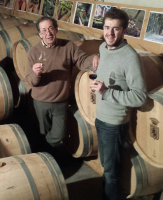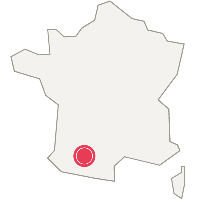You have no items in your shopping cart.
Sud-Ouest
Château Lastours
(38 customer reviews)
Château Lastours is a winery located in the commune of Lisle sur Tarn, in the Tarn department of the Occitanie region. Its name, Lastours, means Las Tours, or The Towers. The estate has belonged to the de Faramond family for at least four centuries. The estate produces red, white and rosé wines, as well as sparkling wine. Find out more
 Recommended by
Recommended byLe Guide Hachette - Wine Enthusiast
-

Estimated delivery between 9 and Jan 11,
-

Garantie anti-casse :
Prise en charge totale
The winemaker
The history of Château Lastours
Château Lastours was a Carolingian villa where Charles-le-Chauve, Charlemagne's grandson, stayed. Around the 11th century, the land passed to the County of Toulouse. After the vines were ravaged in the early 13th century during the Albigensian Crusade, it wasn't until Henry IV's peace at the start of the Renaissance that the vineyards regained their splendor.
A little later, Jean-André Bourdès, a colorful heir, set about rebuilding Château Lastours and reorganizing its exteriors, including the long driveway that still leads to the château today.
His niece, Virginie Subsol de Fontgaudran, inherited Château Lastours, whose vineyards covered 12 hectares at the time. Between 1830 and 1850, she developed the estate and enlarged the winery. In the 1950s, Jean de Faramond inherited Château Lastours, which had just been ravaged by fire and the vines by phylloxera and severe frosts. Jean rebuilt the estate over a period of more than twenty years. Since 2013, his descendant Louis de Faramond has managed Château Lastours.
The Château Lastours vineyard
The Château Lastours vineyard covers 52 hectares, with two-thirds in red and one-third in white. The average age of the vines is 35 years. The red grape varieties are Braucol or Fer-Servadou and Duras. They are complemented by Syrah, Merlot and Cabernet Sauvignon. White grapes include Mauzac, Loin-de-l'œil (typically Gaillacois), Muscadelle, Semillon and Sauvignon.
The Gaillac AOC extends around the river Tarn. The soils are more or less chalky, stony, sandy, clayey or schistose. Sandy soils produce lighter, finer wines than those from clay soils. Soil also influences tannins, aromas and color density.
AOC Gaillac is available in red and white, and uses a wide range of grape varieties. Château Lastours features Loin de l'œil (renowned for its exotic fruit aromas) and Mauzac. Sauvignon, Muscadelle and Ondenc are used as secondary grape varieties. Braucol and Duras are used for red wines.
The wines of Château Lastours
The Ancestral Method
Méthode Ancestrale is made from the Mauzac grape variety. The wine is bottled before fermentation is complete, allowing natural effervescence to be generated, without the need to add tirage liqueur or sugar. The result is a sweet wine that is also available in a rosé version, made from the Duras grape variety. Méthode Ancestrale is perfect for aperitifs and red fruit desserts.
AOC Gaillac - Blanc Sélection
Château Lastours Blanc Sélection is made with the Loin de l'œil grape variety, blended with Sauvignon. It is a round, delicate wine. Its aromas are reminiscent of hazelnuts and butter. It's a fresh summer wine that lends itself to fish starters and lemon desserts.

Registered since 01/04/2016

Lieu Dit Lastours ,
81310 Lisle sur Tarn
81310 Lisle sur Tarn

10 wines available
between 8.5 € and 18.5 €
between 8.5 € and 18.5 €

102 wine's scans
on Twil application
on Twil application

Best rated wines on Twil :
You might like Voir tous les vins de la région
- -32%





























 TWIL - Achat de Vin
TWIL - Achat de Vin


